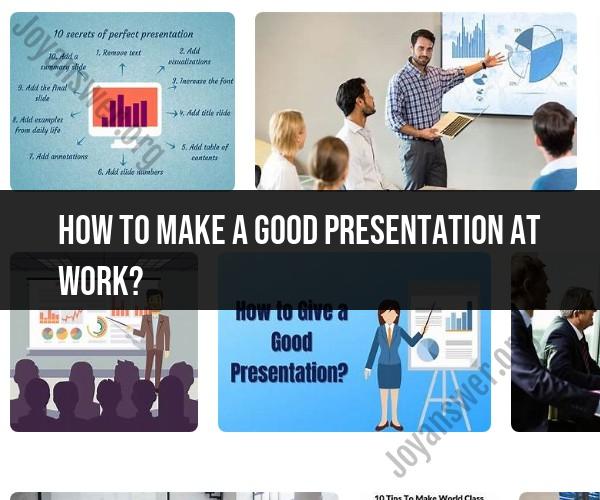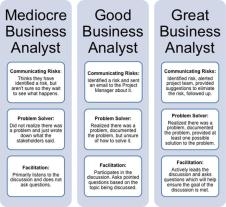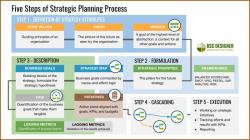How to make a good presentation at work?
Creating an effective workplace presentation can significantly impact your ability to convey information, persuade others, and achieve your professional goals. Here are some tips for making a good presentation at work:
Understand Your Audience:
- Before you start creating your presentation, consider who your audience is. What are their interests, needs, and expectations? Tailor your content and style to resonate with them.
Define Clear Objectives:
- Clearly define the purpose and objectives of your presentation. What do you want your audience to know, understand, or do after the presentation? Having clear goals will guide your content.
Structure Your Presentation:
- Organize your presentation logically with a clear beginning, middle, and end.
- Use a structured outline with headings and subheadings to make it easy for the audience to follow.
Engaging Opening:
- Start with a compelling opening that grabs the audience's attention. This can be a story, a surprising fact, a question, or a quote.
Visual Aids:
- Incorporate visual aids such as slides, charts, graphs, and images to complement your content.
- Keep slides uncluttered, using visuals to reinforce key points rather than as a text-heavy crutch.
Content Clarity:
- Use clear and concise language. Avoid jargon or technical terms that your audience may not understand.
- Focus on delivering your main message effectively.
Engage Your Audience:
- Encourage audience participation through questions, polls, or discussions.
- Use stories and examples to illustrate your points and make them relatable.
Practice and Rehearse:
- Practice your presentation multiple times to become familiar with the content and flow.
- Rehearse in front of a colleague or record yourself to evaluate your delivery.
Manage Your Time:
- Respect your allotted presentation time. Keep track of time during your practice runs to ensure you stay within your time limit.
Body Language:
- Maintain eye contact with your audience. Avoid reading directly from your slides or notes.
- Use gestures and movement purposefully, but don't overdo it.
Confidence and Positivity:
- Project confidence and enthusiasm. Believing in your message can influence your audience's perception.
- Stay positive and maintain a professional demeanor, even if you encounter challenges.
Address Questions and Concerns:
- Be prepared to answer questions and address concerns from your audience. Anticipate potential questions and rehearse your responses.
Use Technology Effectively:
- Ensure that any technology you're using, such as projectors or microphones, is functioning correctly.
- Have a backup plan in case of technical issues.
Feedback and Continuous Improvement:
- After your presentation, seek feedback from colleagues or supervisors to identify areas for improvement.
- Use this feedback to refine your presentation skills for future opportunities.
Follow Up:
- After the presentation, follow up with any promised information, resources, or action items promptly.
Remember that effective workplace presentations require practice and refinement. As you gain experience and receive feedback, your presentation skills will improve, and you'll become a more confident and persuasive communicator in professional settings.
Mastering Workplace Presentations: Strategies for Success
Workplace presentations are an essential skill for professionals of all levels. Whether you are giving a presentation to your team, your manager, or a group of clients, it is important to deliver a professional and polished performance.
Here are some strategies for mastering workplace presentations:
- Know your audience: Tailor your presentation to the specific needs and interests of your audience. What do they already know about the topic? What do they need to know? What are they hoping to learn?
- Have a clear message: What is the one main point that you want your audience to take away from your presentation? Make sure that your entire presentation is focused on communicating this message clearly and concisely.
- Be organized: Structure your presentation in a logical way and use clear transitions to move between sections. This will make your presentation easier to follow for your audience.
- Use visuals: Visuals can help to make your presentation more engaging and informative. Use images, videos, and charts to illustrate your points and capture your audience's attention.
- Practice, practice, practice!: The more you practice your presentation, the more confident and polished you will be on the day of your delivery. Practice your presentation in front of a mirror, with a friend or family member, or even in front of a group of colleagues.
Elevating Your Presentation Skills at Work: Tips and Techniques
Here are some additional tips and techniques for elevating your presentation skills at work:
- Use storytelling: People are more likely to be engaged by a story than by a series of facts and figures. Try to structure your presentation around a central story or narrative.
- Be enthusiastic: If you are passionate about your topic, it will show in your presentation. Speak with enthusiasm and conviction, and your audience will be more likely to be engaged.
- Use humor: Adding humor to your presentation can help to lighten the mood and make it more enjoyable for your audience. However, it is important to use humor appropriately and to avoid making jokes that could be offensive.
- Be interactive: Involve your audience in your presentation by asking questions, conducting polls, or inviting them to participate in activities.
- Get feedback: Ask a trusted colleague or manager to watch your presentation and give you feedback. This feedback can help you to identify areas where you can improve.
Presentation Excellence: How to Deliver a Stellar Performance
On the day of your presentation, be sure to arrive early to set up and to give yourself time to relax and focus. Take a few deep breaths before you begin your presentation and remind yourself that you are prepared.
When you are delivering your presentation, be sure to make eye contact with your audience and speak clearly and slowly. Use your hands and body language to emphasize your points and to engage your audience.
If you make a mistake, don't dwell on it. Simply move on and continue with your presentation. At the end of your presentation, be sure to thank your audience for their time.
By following these strategies and tips, you can deliver stellar presentations at work that will impress your audience and help you to achieve your professional goals.













